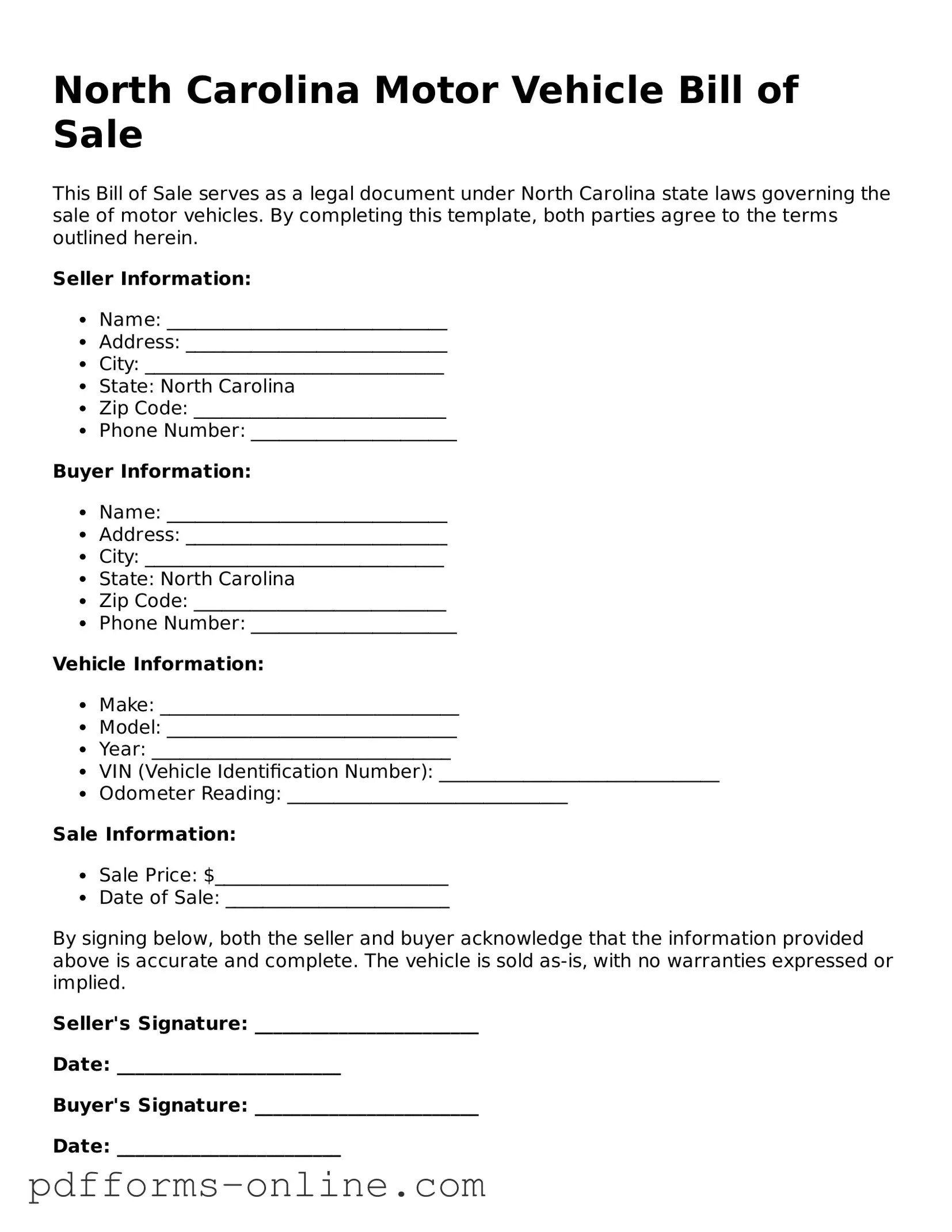The North Carolina Motor Vehicle Bill of Sale form shares similarities with the Vehicle Title Transfer form. Both documents serve as official records for transferring ownership of a vehicle from one party to another. The Vehicle Title Transfer form requires information such as the vehicle identification number (VIN), the seller’s and buyer’s details, and the sale price, mirroring the essential components found in the bill of sale. This ensures that the transaction is documented and legally recognized by the state.
Another document that is comparable is the Odometer Disclosure Statement. This form is often required when selling a vehicle, as it provides a record of the vehicle’s mileage at the time of sale. Similar to the Motor Vehicle Bill of Sale, it protects both the buyer and seller by preventing odometer fraud. Both documents require signatures from the seller and buyer, affirming the accuracy of the information provided.
The North Carolina Vehicle Registration Application also resembles the Motor Vehicle Bill of Sale in purpose. While the bill of sale documents the sale, the registration application is necessary for the buyer to officially register the vehicle in their name. Both forms require the same key vehicle details, such as the VIN and the previous owner's information, ensuring a seamless transition of ownership in the eyes of the state.
The Affidavit of Ownership is another relevant document. This form is used when an individual claims ownership of a vehicle but lacks a title or bill of sale. It serves a similar function by establishing proof of ownership, much like the Motor Vehicle Bill of Sale. Both documents require the individual to provide personal details and vehicle information, reinforcing the legitimacy of the ownership claim.
The North Carolina DMV Application for Title is also related. This document is necessary when applying for a new title after purchasing a vehicle. It includes similar information to the Motor Vehicle Bill of Sale, such as the buyer’s and seller’s names and the vehicle details. Both forms are essential for completing the ownership transfer process and ensuring that the new owner has the legal right to the vehicle.
In addition, the Sales Tax Declaration form is pertinent. When a vehicle is sold, sales tax must be collected based on the sale price. The Sales Tax Declaration form requires the same information found in the Motor Vehicle Bill of Sale, such as the sale price and buyer’s information. Both documents work together to ensure compliance with tax regulations during the vehicle transfer process.
The Release of Liability form is another important document. This form protects the seller by notifying the state that they are no longer responsible for the vehicle after the sale. Similar to the Motor Vehicle Bill of Sale, it requires details about the vehicle and both parties involved in the transaction. This helps to prevent future liabilities related to the vehicle for the seller.
The Vehicle Donation Receipt is also akin to the Motor Vehicle Bill of Sale. This document is used when a vehicle is donated rather than sold. It serves to document the transfer of ownership and provides proof for tax deductions. Both forms require similar information about the vehicle and the parties involved, ensuring that the transaction is recorded properly.
Finally, the Power of Attorney for Vehicle Transactions can be compared to the Motor Vehicle Bill of Sale. This document allows one party to act on behalf of another in vehicle-related matters. It often accompanies the bill of sale when a seller authorizes someone else to complete the sale. Both documents require detailed information about the vehicle and the parties involved, ensuring clarity and legality in the transaction.
